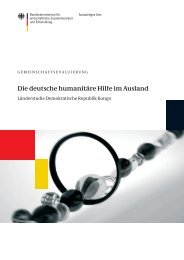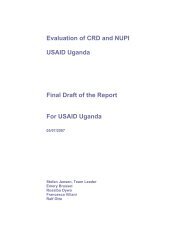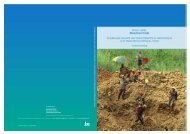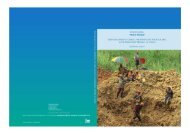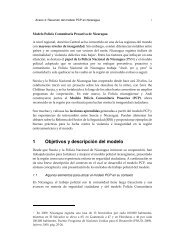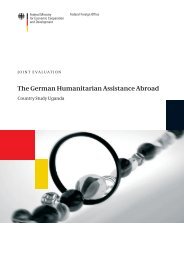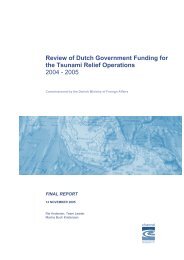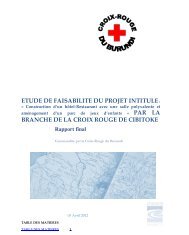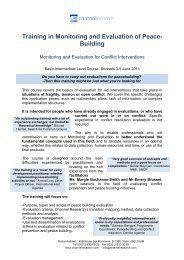A ripple in development? - Channel Research
A ripple in development? - Channel Research
A ripple in development? - Channel Research
You also want an ePaper? Increase the reach of your titles
YUMPU automatically turns print PDFs into web optimized ePapers that Google loves.
Shelter and hous<strong>in</strong>g have been salient aspects of relief and rehabilitation<br />
programmes <strong>in</strong> terms of volumes and perceptions: 44% of<br />
respondents to our survey <strong>in</strong> Aceh see hous<strong>in</strong>g as the priority item. Of all<br />
aspects of life, the tsunami was particularly damag<strong>in</strong>g to habitat. In Indonesia<br />
alone, it destroyed 127,325 homes, and damaged 151,000 more 52 .<br />
At the time of writ<strong>in</strong>g <strong>in</strong> all three countries people rema<strong>in</strong> displaced<br />
where reconstruction has not yet been completed – or <strong>in</strong> some<br />
cases, not yet started 53 . In December 2008 the Asian Development Bank<br />
Institute 54 states that 30,000 houses rema<strong>in</strong>ed to be built.<br />
BRR officials have praised the fact that at the time of the evaluation<br />
more than 120,000 homes, 3,500 kilometers of roads, 266 bridges,<br />
20 ports, 12 airports, 954 health facilities, 1,450 school build<strong>in</strong>gs and<br />
979 public offices had been reconstructed. But the process clearly<br />
rema<strong>in</strong>s <strong>in</strong>complete 55 .<br />
This means that the process of community reconstruction is still<br />
ongo<strong>in</strong>g, or that new communities have been created. In densely-populated<br />
parts of suburban Colombo, where people migrated to seek assistance,<br />
as well as <strong>in</strong> Ampara and <strong>in</strong> most affected sites <strong>in</strong> the north, many<br />
are still <strong>in</strong> temporary shelter, with little hope of gett<strong>in</strong>g permanent<br />
homes soon. This comb<strong>in</strong>es with displacement caused by war <strong>in</strong> both<br />
Indonesia and Sri Lanka, and po<strong>in</strong>ts to the central nature of hous<strong>in</strong>g.<br />
A high number of survey respondents <strong>in</strong> Sri Lanka (31%) <strong>in</strong>dicated<br />
that access to new hous<strong>in</strong>g was still a major problem whereas it was<br />
significantly lower (18%) <strong>in</strong> Aceh where very few people rema<strong>in</strong> <strong>in</strong> temporary<br />
shelter. In some islands of the Maldives (Meemu Kolufushi and<br />
Gaaf Alif Vil<strong>in</strong>ghili, Nilandhoo and Dhandhoo) people rema<strong>in</strong> displaced<br />
<strong>in</strong> temporary shelters where reconstruction has not yet started 56 .<br />
52<br />
BAPPENAS (2005)<br />
53<br />
The end of 2008 figures are:<br />
• Sri Lanka’s total IDP caseload <strong>in</strong>cludes the 182,802 post-April 2006 IDPs, another 272,712<br />
<strong>in</strong>dividuals displaced by conflict prior to the 2002 Ceasefire Agreement (CFA), and an estimated<br />
26,073 Tsunami IDPs for a total of 481,587. In addition, there are 21,677 Sri Lankan refugees<br />
<strong>in</strong> India <strong>in</strong>clud<strong>in</strong>g 1,240 who have arrived <strong>in</strong> India s<strong>in</strong>ce January 2008. (Source: UN Country<br />
Humanitarian Action Plan, CHAP, August 2008, reported by IDMC, 27 August 2008).<br />
• Aceh (conflict IDPs): As of early 2009, the number of IDPs <strong>in</strong> Aceh is unknown. In 2008, the<br />
Department of Social Affairs estimated that 1,500 households, or roughly 7,500 <strong>in</strong>dividuals, were<br />
still unable to return either because of <strong>in</strong>security or because their houses had been destroyed dur<strong>in</strong>g<br />
the conflict. All were located <strong>in</strong> Bener Meriah regency (ICMC, 2008). Early 2009, the number<br />
of households still wait<strong>in</strong>g for hous<strong>in</strong>g assistance, a large number of whom would be IDPs, is estimated<br />
at 6,300 households, or roughly 30,000 people (Daily Aceh, 26 January 2009).<br />
54<br />
Reconstruction after a Major Disaster: Lessons from the Post-Tsunami Experience <strong>in</strong> Indonesia,<br />
Sri Lanka, and Thailand, 2008<br />
55<br />
In Indonesia, 120,000 homes were reconstructed, which is 600,000 <strong>in</strong>dividuals (with an average<br />
of 5 people per household, us<strong>in</strong>g the CRED criteria for national disasters). Out of the roughly<br />
1 million tsunami-related IDPs, this <strong>in</strong>dicates that a further 400,000 <strong>in</strong>dividuals (80,000 households)<br />
still do not have houses rebuilt, ie. They rema<strong>in</strong> displaced. However, the ADB report<br />
suggests that only 30,000 houses rema<strong>in</strong> to be built, <strong>in</strong>dicat<strong>in</strong>g that 150,000 people will rema<strong>in</strong><br />
displaced. Maldives: Approximately 5,000 tsumani IDPs out of 12,000 <strong>in</strong>itially displaced (MIDP,<br />
Government of the Maldives, November 2008 statistics)<br />
56<br />
NDMC (National Disaster Management Centre, Management of IDPs department). This was set up<br />
the day after the tsunami by MNDF – the m<strong>in</strong>istry entitled Maldives National Defense Force.<br />
74



